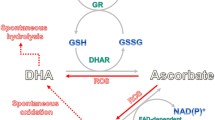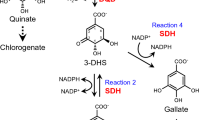Abstract
Dehydroascorbate reductase (DHAR, EC 1.8.5.1) plays a critical role in the regeneration of l-ascorbic acid (AsA). To date, there is virtually no information on the molecular characteristics of DHAR in kiwifruit, an economically and nutritionally important horticultural crop with remarkably high AsA concentration. Here, we isolated two cDNAs encoding putative DHARs (designated as AcDHAR1 and AcDHAR2) from Actinidia chinensis cv. Hongyang. Both in silico and subcellular localization analyses demonstrated that AcDHAR1 and AcDHAR2 were targeted to cytosol and chloroplast, respectively. The recombinant AcDHAR1 and AcDHAR2 were expressed in Escherichia coli and purified using Ni-affinity chromatography. Enzymatic study shows both of them are thermostable and possess a relatively high affinity to dehydroascorbate with an optimal pH ranging from 6 to 8. In addition, transgenic Arabidopsis thaliana plants separately expressing either AcDHAR1 or AcDHAR2 were shown to have significantly increased AsA concentration and enhanced tolerance to salinity. The present study suggested that AcDHAR1 and AcDHAR2 may play a protective role in response to environmental stimuli in kiwifruit.








Similar content being viewed by others
References
Agius F, González-Lamothe R, Caballero JL, Muñoz-Blanco J, Botella MA, Valpuesta V (2003) Engineering increased vitamin C levels in plants by over-expression of a D-galacturonic acid reductase. Nat Biotechnol 21:177–181
Arrigoni O, De Tullio MC (2002) Ascorbic acid: much more than just an antioxidant. Biochim Biophys Acta 1569:1–9
Asada K, Takahashi M (1987) Production and scavenging of active oxygen in photosynthesis. In: Kyle DJ, Osmond CB, Arntzen CJ (eds) Photoinhibition. Elsevier, Amsterdam, pp 228–287
Bradford MM (1976) A rapid and sensitive method for the quantitation of microgram quantities of protein utilizing the principle of protein-dye binding. Anal Biochem 72:248–254
Bulley SM, Rassam M, Hoser D, Otto W, Schünemann N, Wright M, MacRae E, Gleave A, Laing W (2009) Gene expression studies in kiwifruit and gene over-expression in Arabidopsis indicates that GDP-L-galactose guanyltransferase is a major control point of vitamin C biosynthesis. J Exp Bot 60:765–778
Chatterjee IB (1973) Evolution and the biosynthesis of ascorbic acid. Science 182:1271–1272
Chen Z, Gallie DR (2006) Dehydroascorbate reductase affects leaf growth, development, and function. Plant Physiol 142:775–787
Chen Z, Young TE, Ling J, Chang SC, Gallie DR (2003) Increasing vitamin C content of plants through enhanced ascorbate recycling. Proc Natl Acad Sci U S A 100:3525–3530
Cook JD, Reddy MB (2001) Effect of ascorbic acid intake on nonheme-iron absorption from a complete diet. Am J Clin Nutr 73:93–98
Cruz-Rus E, Amaya I, Sánchez-Sevilla JF, Botella MA, Valpuesta V (2011) Regulation of L-ascorbic acid content in strawberry fruits. J Exp Bot 62:4191–4201
Dipierro S, Borraccino G (1991) Dehydroascorbate reductase from potato tubers. Phytochemistry 30:427–429
Dixon DP, Davis BG, Edwards R (2002) Functional divergence in the glutathione transferase superfamily in plants. J Biol Chem 277:30859–30869
Du G, Li M, Ma F, Liang D (2009) Antioxidant capacity and the relationship with polyphenol and vitamin C in Actinidia fruits. Food Chem 113:557–562
Fadzilla NM, Finch RP, Burdon RH (1997) Salinity, oxidative stress and antioxidant responses in shoot cultures of rice. J Exp Bot 48:325–331
Foyer CH, Noctor G (2011) Ascorbate and glutathione: the heart of the redox hub. Plant Physiol 155:2–18
Hossain MA, Asada K (1984) Purification of dehydroascorbate reductase from spinach and its characterization as a thiol enzyme. Plant Cell Physiol 25:85–92
Huang S, Ding J, Deng D et al (2013) Draft genome of the kiwifruit Actinidia chinensis. Nat Commun 4:2640
Huang M, Xu Q, Deng XX (2014) L-Ascorbic acid metabolism during fruit development in an ascorbate-rich fruit crop chestnut rose (Rosa roxburghii Tratt). J Plant Physiol 171:1205–1216
Jiang YC, Huang CY, Wen L, Lin CT (2008) Dehydroascorbate reductase cDNA from sweet potato (Ipomoea batatas [L.] Lam): expression, enzyme properties, and kinetic studies. J Agric Food Chem 56:3623–3627
Kabir MH, Wang MH (2010) Expression pattern of two dehydroascorbate reductase genes from tomato (Solanum lycopersicum L.) in response to stress. J Korean Soc Appl Biol Chem 53:668–676
Kato Y, Urano J, Maki Y, Ushimaru T (1997) Purification and characterization of dehydroascorbate reductase from rice. Plant Cell Physiol 38:173–178
Larkin MA, Blackshields G, Brown NP, Chenna R, McGettigan PA, McWilliam H, Valentin F, Wallace IM, Wilm A, Lopez R, Thompson JD, Gibson TJ, Higgins DG (2007) Clustal W and Clustal X version 2.0. Bioinformatics 23:2947–2948
Levine M (1986) New concepts in the biology and biochemistry of ascorbic acid. N Engl J Med 314:892–902
Levine M, Dhariwal KR, Welch RW, Wang Y, Park JB (1995) Determination of optimal vitamin C requirements in humans. Am J Clin Nutr 62:1347S–1356S
Li M, Ma F, Liang D, Li J, Wang Y (2010) Ascorbate biosynthesis during early fruit development is the main reason for its accumulation in kiwi. PLoS One 5:e14281
Lorence A, Chevone BI, Mendes P, Nessler CL (2004) myo-Inositol oxygenase offers a possible entry point into plant ascorbate biosynthesis. Plant Physiol 134:1200–1205
Mano J, Hideg E, Asada K (2004) Ascorbate in thylakoid lumen functions as an alternative electron donor to photosystem II and photosystem I. Arch Biochem Biophys 429:71–80
Naqvi S, Zhu C, Farre G, Ramessar K, Bassie L, Breitenbach J, Conesa DP, Ros G, Sandmann G, Capell T, Christou P (2009) Transgenic multivitamin corn through biofortification of endosperm with three vitamins representing three distinct metabolic pathways. Proc Natl Acad Sci U S A 106:7762–7767
Neuhaus JM, Boevink P (2001) The green fluorescent protein (GFP) as reporter in plant cells. In: Hawes CR, Satiat-Jeunemaitre B (eds) Plant cell biology. Oxford University Press, Oxford, pp 127–142
Pandey P, Achary VM, Kalasamudramu V, Mahanty S, Reddy GM, Reddy MK (2014) Molecular and biochemical characterization of dehydroascorbate reductase from a stress adapted C4 plant, pearl millet [Pennisetum glaucum (L.) R. Br]. Plant Cell Rep 33:435–445
Qin A, Shi Q, Yu X (2011) Ascorbic acid contents in transgenic potato plants overexpressing two dehydroascorbate reductase genes. Mol Biol Rep 38:1557–1566
Shimaoka T, Yokota A, Miyake C (2000) Purification and characterization of chloroplast dehydroascorbate reductase from spinach leaves. Plant Cell Physiol 41:1110–1118
Tamura K, Peterson D, Peterson N, Stecher G, Nei M, Kumar S (2011) MEGA5: molecular evolutionary genetics analysis using maximum likelihood, evolutionary distance, and maximum parsimony methods. Mol Biol Evol 28:2731–2739
Tang ZX, Yang HL (2013) Functional divergence and catalytic properties of dehydroascorbate reductase family proteins from Populus tomentosa. Mol Biol Rep 40:5105–5114
Urano JI, Nakagawa T, Maki Y, Masumura T, Tanaka K, Murata N, Ushimaru T (2000) Molecular cloning and characterization of a rice dehydroascorbate reductase. FEBS Lett 466:107–111
Ushimaru T, Nakagawa T, Fujioka Y, Daicho K, Naito M, Yamauchi Y, Nonaka H, Amako K, Yamawaki K, Murata N (2006) Transgenic Arabidopsis plants expressing the rice dehydroascorbate reductase gene are resistant to salt stress. J Plant Physiol 163:1179–1184
Wang Z, Xiao Y, Chen W, Tang K, Zhang L (2010) Increased vitamin C content accompanied by an enhanced recycling pathway confers oxidative stress tolerance in Arabidopsis. J Integr Plant Biol 52:400–409
Wheeler GL, Jones MA, Smirnoff N (1998) The biosynthetic pathway of vitamin C in higher plants. Nature 393:365–369
Wolucka BA, Van Montagu M (2003) GDP-mannose 3′,5′-epimerase forms GDP-L-gulose, a putative intermediate for the de novo biosynthesis of vitamin C in plants. J Biol Chem 278:47483–47490
Yang H, Zhao Y, Wang C, Yang Z, Zeng Q, Lu H (2009) Molecular characterization of a dehydroascorbate reductase from Pinus bungeana. J Integr Plant Biol 51:993–1001
Yin L, Wang S, Eltayeb AE, Uddin MI, Yamamoto Y, Tsuji W, Takeuchi Y, Tanaka K (2010) Overexpression of dehydroascorbate reductase, but not monodehydroascorbate reductase, confers tolerance to aluminum stress in transgenic tobacco. Planta 231:609–621
Zhang X, Henriques R, Lin SS, Niu QW, Chua NH (2006) Agrobacterium-mediated transformation of Arabidopsis thaliana using the floral dip method. Nat Protoc 1:641–646
Zou L, Li H, Ouyang B, Zhang J, Ye Z (2006) Cloning and mapping of genes involved in tomato ascorbic acid biosynthesis and metabolism. Plant Sci 170:120–127
Acknowledgments
This work was supported by the National Natural Science Foundation of China (Nos. 31471157 and 31461143008), the National Basic Research Program of China (973 Program) (No. 2011CB100401), a Key Project from the Government of Sichuan Province (No. 2013NZ0014), a Project from the Government of Anhui Province (No. 2012AKKG0739), and a National Science Fund for Distinguished Young Scholars (No. 30825030).
Author information
Authors and Affiliations
Corresponding authors
Ethics declarations
The Ethical Statement
We all have read the Instructions for Authors carefully and fully comply with the ethical standards. This research did not involve human participants and/or animals.
Conflict of Interest
The authors declare that they have no competing interests.
Additional information
Fangfang Liu and Xiuhong Guo contributed equally to this work.
Electronic Supplementary Material
Below is the link to the electronic supplementary material.
ESM 1
(PDF 1286 kb)
Rights and permissions
About this article
Cite this article
Liu, F., Guo, X., Yao, Y. et al. Cloning and Function Characterization of Two Dehydroascorbate Reductases from Kiwifruit (Actinidia chinensis L.). Plant Mol Biol Rep 34, 815–826 (2016). https://doi.org/10.1007/s11105-015-0965-8
Published:
Issue Date:
DOI: https://doi.org/10.1007/s11105-015-0965-8




